If not much international attention has been paid to Paraguay's economy in recent times, even less is known about its financial and banking systems. More than two-thirds of the country's local market is served by banks, while co-operatives have a 15% market share. Financieras (institutions that can issue loans but are not authorised to hold savings accounts) and casas de creditos and casas de empeños (pawn brokers) share the rest.
Paraguay's stock exchange, Bolsa de Valores y Productos de Asunción, was created in 1977 but has limited activity. Most local businesses are too small to float and, at best, resort to private placements for financing. As is to be expected, multinationals present in the country access the international capital markets to finance their local activities. On the investors' side, it is mainly banks that buy government bonds and a development of the country's pension fund system is urgently required.
"We need a more developed stock exchange," says Jerónimo Nasser, president of Paraguay's banking association and general manager of Citibank in Paraguay, "but it is not a priority as the majority of companies are family-owned and do not open their capital to shareholders."
Mr Nasser is correct in his assertion that Paraguay's stock exchange is not high on the country's list of priorities; there still is much to be done in basic banking activities, and this is where most of the growth opportunities lie.
Consolidation force
Since the mid-1990s, Paraguay's financial system has been going through a process of consolidation and strengthening. This was forced in part by a series of fraud cases that affected the weakly regulated financieras, which in some cases had been used to cover up usury activities.
In addition to such home-grown problems, Paraguay has also suffered from wider financial crises such as Argentina's troubles in the early-2000s. As with the majority of Latin American countries, Paraguay emerged from each of these crises with stronger banking regulation and supervision.
Paraguay's lenders all comfortably meet international capital requirements standards and have very few embedded derivatives in their balance sheets. There are also strong controls on maturity mismatches. "The banking sector is regulated in all of its activities," says German Rojas, vice-chairman of Sudameris Bank and former governor of Paraguay's central bank. "There is no other sector that is regulated as much."
The traditional short-termism of banking clients and the banks themselves is slowly changing. It still presents a significant challenge, however, as 65% of the country's deposits are short term ones. Economic growth and the creation of a local financial development agency are helping to change this.
A growing portion of the population is gaining access to disposable income, which can be put into savings accounts. More importantly, the Agencia Financiera de Desarollo (AFD) has accelerated the speed of this change by providing long-term financing to banks as a counterpart to their long-term lending to individuals and businesses.
"Thanks to AFD, banks can now issue 20-year loans at competitive interest rates and in guaraní," says Ronald Granados, president of AFD. "This never happened before. There weren't any mortgages before the agency was born."
AFD was created in 2005, and since then Paraguay's banks have become increasingly more comfortable in offering long-term products. They have been further reassured by a close-to-zero rate for non-performing loans on mortgages for all the banks that started offering them. Between January 2006 and June 2010, AFD approved just under $94m-worth of financing operations.
AFD has also helped calm unusual fluctuations in foreign exchange that has been a scourge in Paraguay. Mr Granados remembers how in 2003 the exchange rate between the dollar and guaraní doubled during just one day, only to readjust to its regular rate in the following days. This was due to an unusually high demand for the US currency by individuals, earning in guaraní, who would use the money to buy cars or to partly finance the purchase of a house. Similar financing would now be provided by banks in the local currency.
Economy drive
Paraguay's fast-growing economy has pushed more corporates and individuals towards banking products but the penetration of the banking system remains far from ideal. "Talking to bankers, they say there is still a big bancarisation margin," says central bank governor Jorge Corvalán. "We historically had a 30% loans to gross domestic product [GDP] ratio. We had severe banking crises in 1995, 1998 and 2002, when some banks went bankrupt and deposits to GDP reduced to between 17% and 15%. Deposits are now about 35% of GDP. If you look at countries such as Chile, they have deposits to GDP at 80% or 90%. That is what we want, too."
The central bank's contribution to the bancarisation process has come through the creation of a real-time clearing system.
Currently, it takes about six hours to clear positions, which creates a liquidity risk and limits banks in their activities.
The Banco Central de Paraguay is a respected institution in the country and its independence unquestioned. "Politics does not play a role in banking," says Mr Nasser. "There is a clear understanding about the importance of the central bank's independence," adds Roberto Heitter, general manager of Paraguay's banking association. However, he cannot resist a dig at the current government. "Banks can't plan their long-term expansion until there is a long-term plan for Paraguay from the government."
Interest rates are still very high, with spreads of between 8% and 12%, but banks are engaging in increasingly strong competition. The consolidation process that started at the beginning of 2002 is continuing and, in private, some bankers say that more mergers and acquisition activity will surface very soon.
Since the Argentina-ignited crisis in 2002, the number of lenders in Paraguay has reduced by half. This figure now stands at 15, including state lender Banco Nacional de Fomento (BNF).
Growing market
"This is a very competitive system and all the banks are growing," says Mr Nasser. "The only way to significantly and quickly increase market share is to buy a bank."
All banks are indeed growing, both in terms of their activities and numbers of branches - sometimes at a speed the local real estate sector cannot handle, meaning that when the decision is made to build a branch, there might be a three-month wait for the cement.
If tougher regulation has been developed for banks, some financial institutions are still fairly lightly supervised. This is the case of the co-operatives, to which many Paraguayans switched their accounts during the various financial crises as banks fell into trouble.
Although limited in size and interconnectivity to the rest of the financial system, as Mr Corvalan explains in his interview with The Banker, new technology and operating systems are currently being introduced to address the issue of their risk management systems.
Paraguay's financial market is still small and underdeveloped but offers great opportunities. Besides, being small in a physical sense has its advantages, as Sebastien Lahaie, member of the board of directors of Sudameris Bank, points out: "Paraguay is such a small market that information flows very quickly. It is as close to an efficient market as it can be."
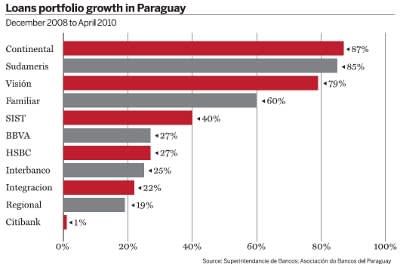
Loans portfolio growth in Paraguay
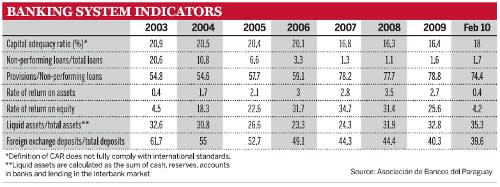
Banking system indicators
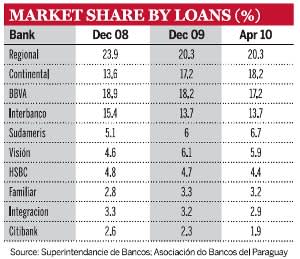
Market share by loans (%)
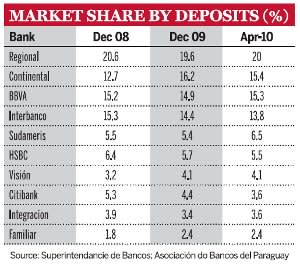
Market share by deposits (%)
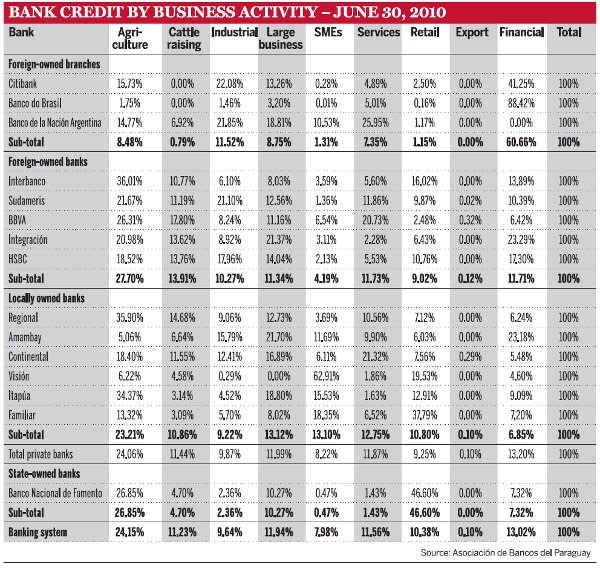
Bank credit by business activity - June 30, 2010













